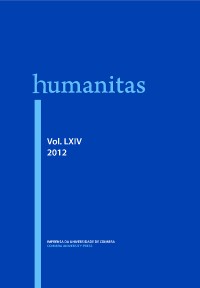Please use this identifier to cite or link to this item:
https://hdl.handle.net/10316.2/27384| DC Field | Value | Language |
|---|---|---|
| dc.contributor.author | Miranda, Margarida | - |
| dc.date.accessioned | 2013-12-19T12:09:06Z | |
| dc.date.accessioned | 2020-10-02T17:03:25Z | - |
| dc.date.available | 2013-12-19T12:09:06Z | |
| dc.date.available | 2020-10-02T17:03:25Z | - |
| dc.date.issued | 2012 | - |
| dc.identifier.issn | 2183-1718 | - |
| dc.identifier.uri | https://hdl.handle.net/10316.2/27384 | - |
| dc.description.abstract | Durante os séculos XVIII e XIX e em parte do XX, a afinidade natural entre teatro e retórica, actor e orador, parece ter passado despercebida; hoje em dia o estudo do teatro dos Jesuítas está ainda limitado por perspectivas estritamente literárias e catequéticas, que deixam de lado, ou mesmo excluem, outros pontos de vista essenciais para uma compreensão plena de tal ligação. Neste estudo, o objectivo da Autora é demonstrar que a teatralidade do discurso retórico não só contribuiu para a produção de uma obra teatral específica, como também converteu categorias retóricas em instrumentos operativos adequados à compreensão do teatro jesuítico e à sua manifestação por natureza plural, incluindo dança e música. A doutrina retórica clássica permite ao teatro dos Jesuítas expandir a sua dimensão artística, conjugando aspectos filosóficos e parenéticos, oratórios e dramáticos, além dos estritamente poético-literários. | por |
| dc.description.abstract | During the 18th, 19th and part of the 20th centuries the natural affinity between theatre and oratory, actor and orator, seems to have gone unnoticed; nowadays the study of the Jesuit theatre is still restricted by strictly literary or catechatical perspectives, which thus leaves aside and even excludes other viewpoints essential to the full understanding of such a link. In this study the Author’s aim is to demonstrate that the theatricality of oratory discourse not only contributed to the production of a specific theatrical work, but also turned rhetorical categories into the operative tools the most fit to understand Jesuit theatre and its inherent plural manifestations, dance and music included. Classical rhetorical doctrine enables the Jesuit theatre to display its artistic dimension as a whole, encompassing the philosophical and parenetic, oratorical and scenic-dramatic aspects, rather than just the poetic-literary aspects. | eng |
| dc.language.iso | por | - |
| dc.publisher | Imprensa da Universidade de Coimbra | - |
| dc.subject | Rhetoric | eng |
| dc.subject | Jesuit Theatre | eng |
| dc.subject | Oratory | eng |
| dc.subject | Colleges | eng |
| dc.subject | Pedagogy | eng |
| dc.subject | Humanism | eng |
| dc.subject | Retórica | por |
| dc.subject | teatro dos jesuítas | por |
| dc.subject | colégios | por |
| dc.subject | pedagogia | por |
| dc.subject | humanismo | por |
| dc.title | A retórica, chave de leitura do teatro jesuítico | por |
| dc.type | article | - |
| uc.publication.collection | Humanitas vol. LXIV | - |
| uc.publication.firstPage | 115 | - |
| uc.publication.lastPage | 126 | - |
| uc.publication.location | Coimbra | - |
| uc.publication.journalTitle | Humanitas | - |
| uc.publication.volume | 64 | por |
| dc.identifier.doi | 10.14195/2183-1718_64_7 | - |
| uc.publication.section | Artigos | - |
| uc.publication.orderno | 7 | - |
| uc.publication.area | Artes e Humanidades | - |
| uc.publication.manifest | https://dl.uc.pt/json/iiif/10316.2/27384/257979/manifest?manifest=/json/iiif/10316.2/27384/257979/manifest | - |
| uc.publication.thumbnail | https://dl.uc.pt/retrieve/12008218 | - |
| item.grantfulltext | open | - |
| item.fulltext | With Fulltext | - |
| Appears in Collections: | HVMANITAS | |
Files in This Item:
| File | Description | Size | Format | |
|---|---|---|---|---|
| humanitas64_artigo7.pdf | 416.47 kB | Adobe PDF |  |
Items in DSpace are protected by copyright, with all rights reserved, unless otherwise indicated.
